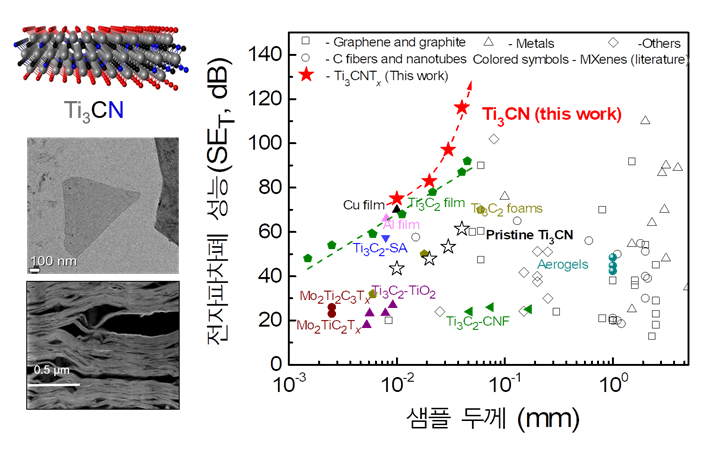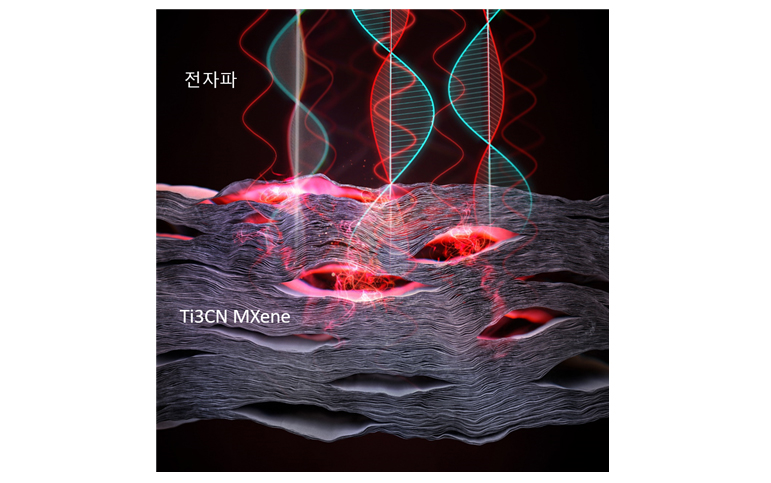Professor Koo Chong-min and Professor Kim Myung-ki’s joint research team has developed a nanomaterial featuring extremely high electromagnetic wave shielding and absorption characteristics.
The Ti3CN MXene electromagnetic wave absorption material is applicable to mobile electronic and communication devices and defense technology.
This novel material that has overcome the limitations of conventional shielding technology was published in the journal, Science.

▲ (From left) Professor Koo Chong-min, Professor Kim Myung-ki, and Kwon Ji-sung (master student) from KU-KIST
An ultra-lightweight electromagnetic wave shielding and absorption MXene material that has overcome the limitations of conventional shielding materials has been developed. This material is expected to be applied to highly integrated mobile electronic and communication devices as well as defense technologies requiring electromagnetic wave shielding, such as stealth technology.
* MXene: A two-dimensional nanomaterial that is lighter and less costly than metals and is applicable to flexible printing. The ceramic material shows better electromagnetic wave shielding performance than the conventional metallic materials
The joint research team of Professor Koo Chong-min (University-Research Institute Professor of KU-KIST Graduate School of Converging Science and Technology, Head of the Materials Architecturing Research Center at KIST), Professor Kim Myung-ki (Full-Time Professor of KU-KIST Graduate School of Converging Science and Technology), and Professor Yury Gogotsi (Drexel University, United States) has successfully developed a Ti3CN MXene-based electromagnetic wave adsorption material that can drastically improve the electromagnetic interference (EMI) issue.
※ (Title of article) Anomalous Absorption of Electromagnetic Waves by 2D Transition Metal Carbonitride Ti3CN (MXene)
The results of this study were published in Science (IF 41.063), one of the most authoritative academic journals in the world, on July 24 (12 a.m. KST).
With the recent advancements in highly integrated electronic and communication devices, there is an increasing need to develop a lightweight and highly absorptive material for electromagnetic wave shielding and absorption. Conventional electromagnetic wave shielding is centered on metallic materials, which have high electric conductivity. However, metals are heavy, expensive, and difficult to apply to flexible printing processes due to the irregular structures involved, making metals inappropriate for highly integrated electronic and communication devices. In addition, the strong electromagnetic wave reflection by electrically conductive metals causes secondary damage through hazardous reflected electromagnetic waves. To overcome these problems, the research team developed Ti3C2 MXene-based electromagnetic wave shielding technology and published about it in Science in 2016. However, the absorption characteristics required improvement in order to avoid the aforementioned secondary damage caused by hazardous reflected electromagnetic waves.
* Ti3C2 MXene: A compound of titanium transition metal and carbon. The nanomaterial has a 2D flat structure 1 nm thick.
In the present study, the team developed a Ti3CN MXene nanomaterial featuring extremely high absorption characteristics, overcoming the limitations of conventional MXene-based materials.
* Ti3CN MXene: A compound of titanium, carbon and nitrogen. Its structure is similar to that of Ti3C2 MXene, which has a plate-like structure 1 nm thick. However, the electric conductivity of Ti3CN MXene is lower than that of Ti3C2.
Through a simple thermal treatment, the research team found the meta-structure formation mechanism of Ti3CN MXene film. Based on that mechanism, the team developed a technology for preparing the MXene-based electromagnetic wave shielding material that shows excellent electromagnetic wave absorption characteristics, even at very low film thicknesses, by efficiently controlling the effective permittivity and effective permeability. The material shows a high EMI shielding effectiveness (SE) of 116 dB or more at a thickness of about 40 micrometers, which is similar to the thickness of a hair.
The MXene material is a novel, artificial nanomaterial that does not exist in nature. Securing a supply chain connecting the materials, components and equipment seems to be critical to the commercialization of the material. This requires the establishment of an integrated cooperative research system devoted to the mass production of the nanomaterial, an efficient technology for manufacturing components, and applications to equipment products. The research team has also participated in the development of construction technology for fixed type electromagnetic wave protection structures, endeavoring to develop high-performance thin film-based coating materials for shielding in order to improve the electromagnetic wave protection performance of electromagnetic wave shielding concrete.
This work was supported by the Basic Science Research Program (2017R1A2B3006469) through the Senior Fellow Program of the Ministry of Science, ICT, and Future Planning; the Internal Research program of the Korea Institute of Science and Technology (KIST); and the Construction Technology Research Project of the Ministry of Land, Infrastructure, and Transport.
The research team said, “Our technology prepares an electromagnetic wave shielding and absorption material that is much lighter than the existing materials. The material is expected to be used as an electromagnetic wave shielding and absorption material for highly integrated mobile electronic and communication devices. We hope that it can be applied to electromagnetic pulse shielding and stealth technologies.”
[Description of figures]

(Figure 1) Structure and electromagnetic wave shielding performance of Ti3CN MXene.
As shown in Figure 1, the Ti3CN MXene nanomaterial has a 2D flat structure 1 nm thick. Thermal treatment of the Ti3CN MXene film for meta-structure control forms the porous structure shown in Figure 1. The nanomaterial shows a high electromagnetic interference shielding effectiveness (EMI SE) of 116 dB or higher at a thickness of about 40 micrometers, which is similar to the thickness of a hair.
Source: Professor Koo Chong-min, Korea University

(Figure 2) Schematic diagram of electromagnetic wave absorption by Ti3Cn MXene film.
The excellent electromagnetic wave shielding performance of the Ti3Cn MXene film originates from its unique adsorption characteristics. As shown in Figure 2, when thermally treated Ti3Cn MXene forms a porous meta-structure, which has significantly different effective permittivity and permeability from the original structure. As a result, the material shows very high electromagnetic wave absorption characteristics, and the improved absorption gives a very high EMI SE value.
Source: Professor Koo Chong-min, Korea University



